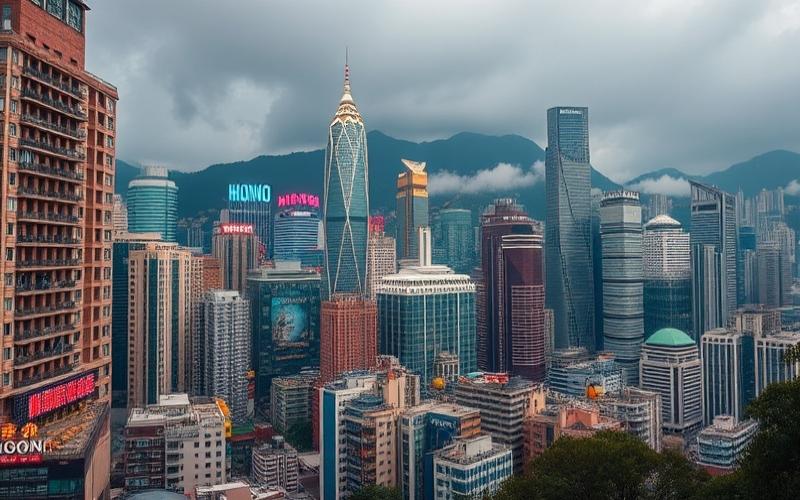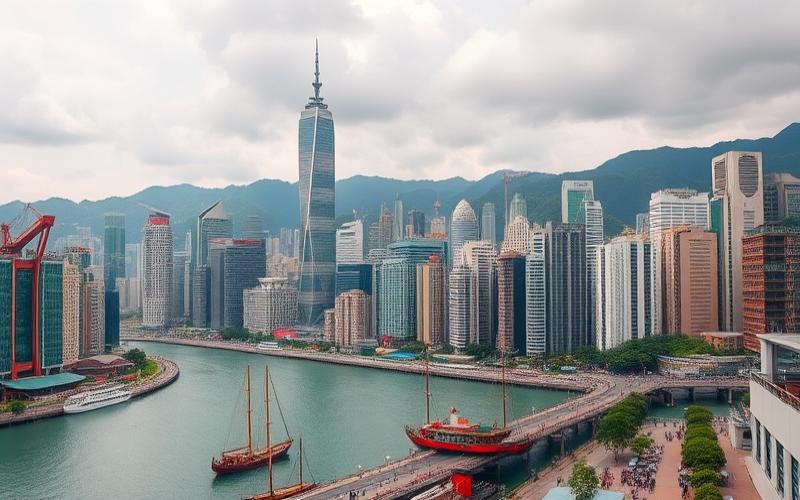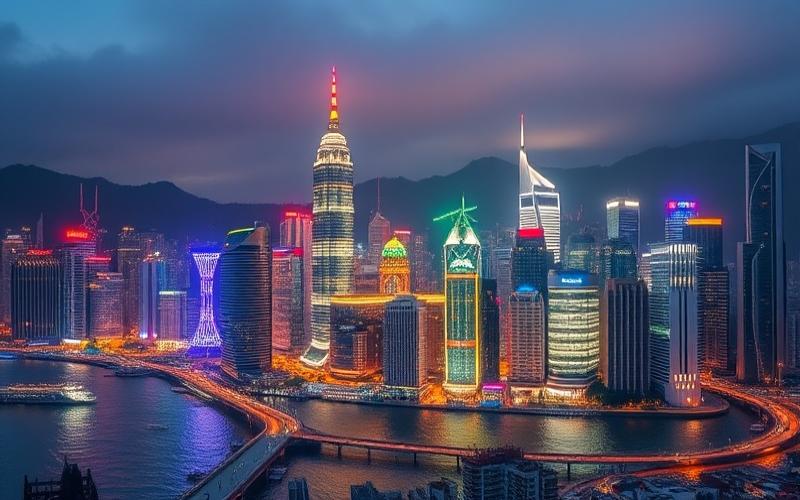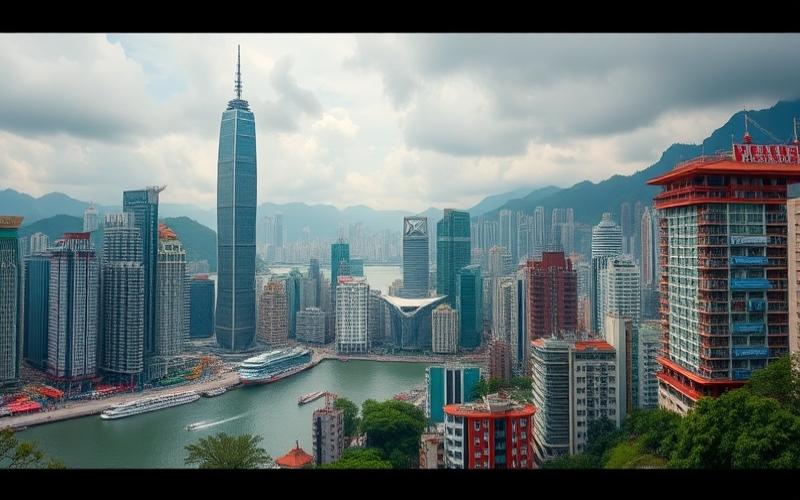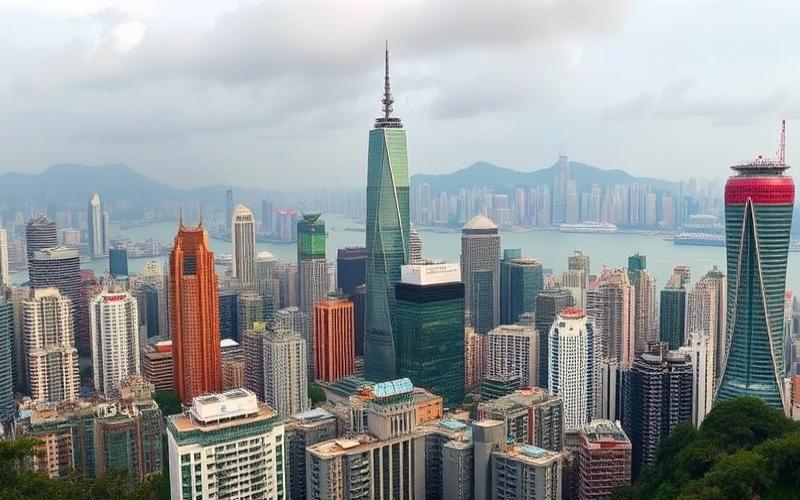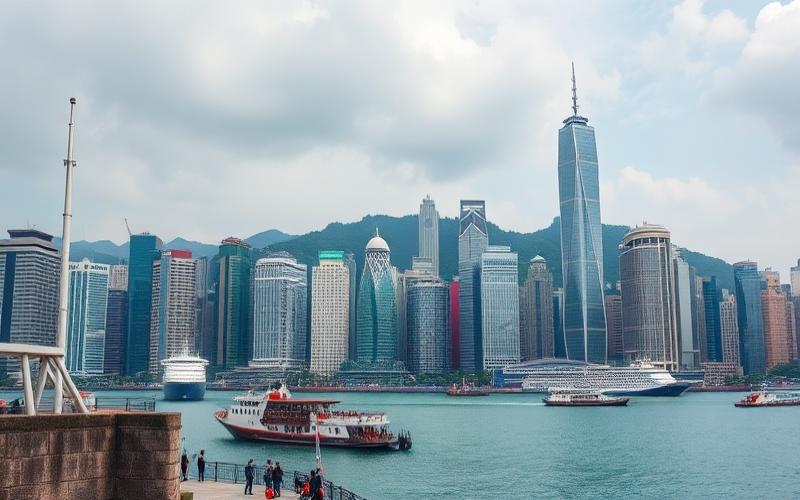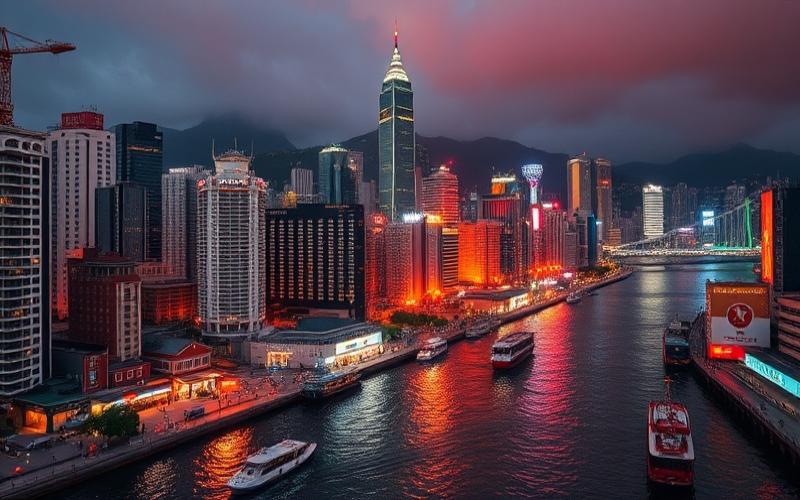
 Published on and written by Cyril Jarnias
Published on and written by Cyril Jarnias
Hong Kong’s real estate market is constantly evolving, and recently, an intriguing phenomenon has emerged: the rise of “dark stores”. These spaces, neither fully retail stores nor simply warehouses, represent a new trend in the retail sector, transforming the already dense urban landscape of this territory.
In response to growing demand for fast and efficient delivery services, these spaces are setting up in often unconventional locations, influencing local real estate dynamics and attracting interest from investors and industry professionals.
This emerging trend raises questions about the economic and social impact of dark stores in a city where land is already scarce and valuable.
Rise of Urban Warehouses in Hong Kong
The rise of urban warehouses, particularly dark stores, is profoundly transforming Hong Kong’s real estate market.
Dark stores, these urban warehouses dedicated to rapid preparation of online orders without public access, are experiencing increased demand, catalyzed by the explosion of e-commerce and rapidly evolving consumer habits.
Factors Explaining the Rise of Urban Warehouses in Hong Kong:
- Growth of Online Commerce: The rise of online shopping requires nearby logistics solutions to accelerate delivery and meet consumer expectations for speed.
- Changing Habits: Urban residents prioritize express delivery, particularly for everyday consumer goods and food, which requires storage points close to dense residential areas.
- Space Constraints: Limited space and high land costs in Hong Kong favor the transformation of former commercial or industrial premises into dark stores rather than building new traditional warehouses.
Economic and Real Estate Impacts:
- Transformation of Real Estate Portfolio: Many vacant commercial spaces, particularly in neighborhoods less frequented since the pandemic, are being converted into dark stores or micro-warehouses.
- Pressure on Traditional Commercial Real Estate: This conversion reduces the supply of premises for traditional physical retail, contributing to declining rents for conventional retail spaces and increasing vacancy in shopping centers.
- Valuation of Certain Assets: Owners of well-located properties, easily accessible for urban logistics, benefit from new demand and can secure stable, even rising, rents.
| Indicator | Recent Value/Trend |
|---|---|
| Warehousing Market Size | 1.75 billion USD (2025 forecast) |
| Expected Annual Growth | 5.55% (2025-2030) |
| Logistics Space Growth | +0.4% per year (2020-2025) |
| Commercial Rent Trend | Continued decline in Q1 2025 |
| Key Transformation Sectors | Rehabilitated commercial spaces and factories |
Main Consequences for the Real Estate Market:
- Decreased vacancy in certain former industrial or commercial spaces thanks to their conversion into dark stores.
- Increased market segmentation, contrasting properties valued for urban logistics with those abandoned by traditional retail.
- Adaptation of real estate investment strategies, with growing interest in assets compatible with e-commerce needs.
Future Outlook for Hong Kong:
- Dark store growth is expected to continue, driven by ongoing digitalization of consumption and expectations for ultra-fast deliveries.
- Urban land scarcity will limit horizontal expansion, favoring the conversion of existing buildings and space optimization.
- Real estate players will need to innovate to capture this new demand, particularly by adapting supply to urban logistics (accessibility, modularity, security).
- Traditional physical retail will be pushed to reinvent itself, focusing on experience or digital complementarity to survive in an environment where urban logistics is taking center stage.
This dynamic positions Hong Kong as an urban logistics laboratory, where the rapid transformation of the real estate sector illustrates the structural impact of e-commerce on the dense 21st-century city.
Good to Know:
The rise of dark stores in Hong Kong, a consequence of increasing online commerce and changing consumer habits, has a notable impact on the local real estate market. Demand for these urban warehouses has led to the transformation of traditional commercial spaces into hyper-organized premises for fast deliveries. This trend is disrupting classic commercial real estate, with increased leasing of flexible spaces specifically dedicated to dark stores, often in more accessible neighborhoods to optimize urban logistics. According to recent data, leasing for these warehouses increased by 15% in 2023, reflecting growing investor interest in this model. As e-commerce continues to develop, this trend is expected to intensify, thereby redefining urban space usage in a land-constrained city like Hong Kong.
The Role of Dark Stores in Logistics Real Estate
Definition and Function of Dark Stores in Modern Retail
A dark store is a logistics warehouse, often organized like a supermarket but closed to the public, dedicated exclusively to preparing and shipping online orders. Products are stored on shelves accessible only to logistics operators who select items to ensure fast delivery, typically within 15 minutes in the context of quick commerce. These spaces thus play a key role as distribution centers for e-commerce brands and enable optimization of inventory management and picking efficiency through extensive use of specialized software (Warehouse Management System) and sometimes automation.
Influence on Logistics Real Estate Demand in Hong Kong
- Hong Kong’s exceptional density makes proximity between storage/urban logistics locations and end consumers crucial.
- The emergence of dark stores has increased demand for suitable premises in city centers or near residential areas to ensure express delivery.
- Faced with chronic lack of available land, sector players must compete to secure strategic locations, causing a notable increase in rental value in this real estate segment.
Impact on Real Estate Prices and Availability: Challenges & Opportunities
| Factor | Main Challenge | Opportunity |
| Price | Upward pressure on urban rents | Profitability through consistent flows |
| Availability | Limited supply: scarcity of adaptable land | Rapid appreciation |
| Compliance | Necessary regulatory adaptation | Quick conversion possible |
- Real estate developers face:
- Competition with other urban uses (traditional retail, offices)
- Difficulties related to standards (noise, increased traffic) imposed by these new logistics models
- Possible volatility linked to rapid e-commerce evolution
Opportunities:
- Accelerated transformation or conversion of underutilized commercial spaces (former physical stores) into dark stores
- Higher valuation compared to standard commercial leases due to the structural dynamism of quick commerce
Differences with Traditional Warehouses and Urban Implications
| Criteria | Dark Store (Urban) | Traditional Warehouse (Peripheral) |
| Location | Central/urban neighborhoods | Industrial/peripheral zones |
| Main Function | Ultra-fast e-commerce order picking | Mass storage/B2B supply |
| Size | Small/medium | Large |
| Customer Access | None | None |
| Traffic Impact | Dense last-mile delivery | Less locally impactful |
Implications:
- Intensification of “last-mile” traffic,
- Increased pressure on urban infrastructure,
- Necessity for cities like Hong Kong to adapt their urban/logistics planning.
Specific Examples / Case Studies – Hong Kong
- Major players such as Foodpanda or Deliveroo have transformed vacant or underutilized commercial premises in Central District or Kowloon into dark stores dedicated to ultra-fast deliveries.
- Some local chains are also experimenting with the “hybrid” model, where certain physical locations simultaneously serve as mini-warehouses invisible to the public while maintaining a limited storefront.
- In response to the critical lack of affordable industrial space in New Territories, some investors are even partially rehabilitating older mixed-use buildings to accommodate these new hybrid uses centered around instant e-commerce.
Key Takeaway:
Dark stores, through their ability to bring inventory closer to the end consumer while optimizing every usable square meter in a dense city like Hong Kong, are profoundly disrupting the local logistics real estate market—generating as many challenges as unprecedented opportunities for both logistics providers and urban real estate developers.
Good to Know:
Dark stores, these warehouses closed to the public dedicated to rapid preparation of online orders, play a crucial role in modern retail in Hong Kong. Their emergence, amplified by growing demand for fast deliveries, has transformed the urban logistics real estate landscape to the point of increasing competition for available spaces. Indeed, their presence requires a well-thought-out real estate strategy, favoring well-located urban premises to optimize delivery times, which has strongly impacted prices and availability of logistics properties. Unlike traditional warehouses often located in peripheral areas, urban dark stores offer a necessary proximity solution to meet the demands of an exacting urban clientele. Neighborhoods like Kowloon have seen a significant increase in installations of these invisible stores, creating challenges but also opportunities for developers, who must now integrate flexibility and efficiency into their real estate projects.
Impact on E-commerce Investment in Hong Kong
E-commerce growth in Hong Kong is experiencing sustained momentum, driven by an expected average annual growth of 7 to 8% until 2029. In 2025, the market is projected to generate 5.34 billion USD in revenue and reach 7.24 billion USD by 2029. E-commerce now represents nearly 9.3% of the region’s total retail sales, a share that is constantly progressing.
Impact on Real Estate Demand and Dark Stores
The rapid increase in online commerce is causing a profound transformation in real estate demand. E-commerce players are seeking spaces adapted to proximity urban logistics, favoring the emergence of “dark stores”—urban warehouses optimized for rapid preparation of online orders and last-mile delivery.
| Year | E-commerce Revenue (USD) | Share of Retail (%) |
| 2024 | 23.5 Bn (total, incl. cross-border) | 8.4 |
| 2025 (projected) | 5.34 Bn (pure retail) | 9.3 |
| 2029 (projected) | 7.24 Bn (pure retail) | — |
Economic and Technological Factors Favoring Investments
- Highly connected population and massive digital adoption.
- Advanced logistics infrastructure (ports, airport hubs, dense urban networks).
- Cross-border trade dynamics: 56% of e-commerce transactions involve international exchanges.
- Investments in automation (robots, warehouse management systems, IoT) to accelerate order preparation and delivery.
- New needs for urban warehouses and flexible spaces, favoring conversion of traditional real estate assets into dark stores.
Recent Statistics on E-commerce Related Real Estate Investment
In 2024, the retail segment of e-commerce in Hong Kong weighs 9 billion USD, driving demand for thousands of new dark stores and urban logistics hubs. The most dynamic categories (apparel, food, home, beauty) alone account for over 50% of online stores, which stimulates the adaptation of many commercial premises into urban logistics centers.
| Category | Number of Dark Stores/Stores | Share of Total (%) |
| Apparel | 8,550 | 23.9 |
| Food & Beverages | 3,910 | 11 |
| Home & Garden | 3,820 | 10.7 |
| Beauty & Fitness | 3,490 | 9.8 |
Challenges for Real Estate Investors and Developers
- Urban Regulation: Zoning constraints, operational limits for logistics warehouses in city centers, tensions with residential fabric.
- Environmental Impact: Multiplication of logistics flows, increased urban congestion, issues related to packaging waste management and warehouse energy consumption.
- Cost and Land Scarcity: Land pressure in Hong Kong makes acquisition or conversion of suitable premises for dark stores complex.
Future Outlook
- E-commerce growth is expected to increase demand for hybrid spaces, at the intersection of commerce, logistics, and urban service.
- Technological innovations (automated warehouses, artificial intelligence for flow optimization, picking robotization) will continue transforming logistics real estate.
- Regulators will need to adapt legislative frameworks to support the rise of dark stores while limiting negative externalities on the city.
- Investors are betting on real estate asset flexibility and integration of eco-responsible solutions to sustain their investments in a rapidly changing market.
E-commerce in Hong Kong acts as a powerful engine of real estate transformation, catalyzing the emergence of dark stores, while posing new regulatory and environmental challenges for sector players.
Good to Know:
The rapid expansion of e-commerce in Hong Kong, with recent growth of nearly 20% per year, has significantly increased demand for real estate spaces adapted to dark stores, these storefront-less shops designed primarily to serve online orders. Technological advancements, such as automation and innovative logistics solutions, further stimulate investments in this sector, with a notable 15% increase in real estate investments dedicated to e-commerce infrastructure in 2022. However, investors and developers must contend with major challenges like Hong Kong’s strict urban regulation and the need to minimize the environmental impact of new constructions. Future outlook indicates a dynamic market but requires continuous adaptation to technological and regulatory evolutions to fully leverage the opportunities offered by the dark store phenomenon.
Disclaimer: The information provided on this website is for informational purposes only and does not constitute financial, legal, or professional advice. We encourage you to consult qualified experts before making any investment, real estate, or expatriation decisions. Although we strive to maintain up-to-date and accurate information, we do not guarantee the completeness, accuracy, or timeliness of the proposed content. As investment and expatriation involve risks, we disclaim any liability for potential losses or damages arising from the use of this site. Your use of this site confirms your acceptance of these terms and your understanding of the associated risks.










